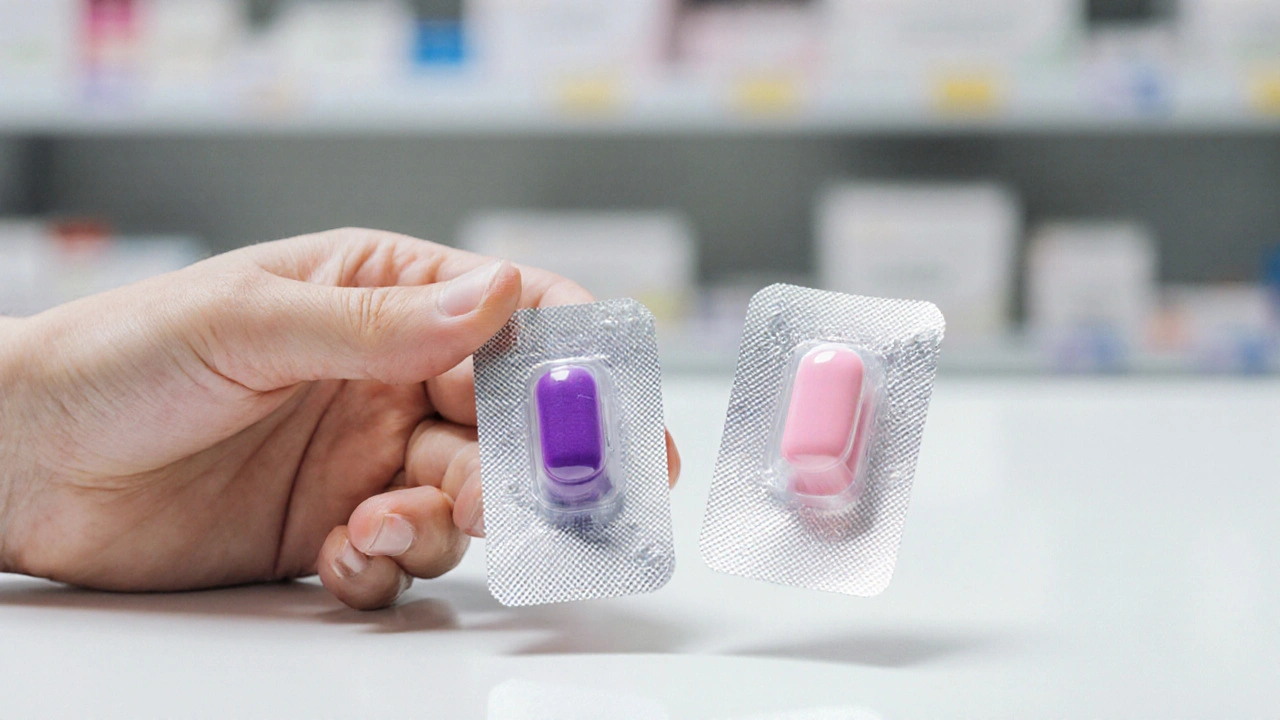Minocycline vs. Other Antibiotics Comparison Tool
This tool helps compare key characteristics of Minocycline and other commonly prescribed antibiotics. Use it to understand their differences in spectrum, uses, dosing, side effects, and cost.
Minocycline
Spectrum: Broad (Gram+/-, atypicals)
Common Uses: Acne, rosacea, pneumonia, rickettsial disease
Typical Dose: 100 mg once daily
Notable Side Effects:
- Pigment changes
- Vestibular issues
- Hepatic injury
Cost: $30-$45 per 30-day supply
Doxycycline
Spectrum: Broad (similar to minocycline)
Common Uses: Lyme disease, acne, travel-related diarrhoea
Typical Dose: 100 mg twice daily
Notable Side Effects:
- Photosensitivity
- Esophageal irritation
Cost: $15-$25 per 30-day supply
Tetracycline
Spectrum: Broad, slightly less potent
Common Uses: Acne, chlamydia, rickettsial infection
Typical Dose: 500 mg four times daily
Notable Side Effects:
- GI upset
- Hepatic enzyme induction
Cost: $10-$20 per 30-day supply
Azithromycin
Spectrum: Moderate (gram+, atypicals)
Common Uses: Community-acquired pneumonia, STIs
Typical Dose: 500 mg day 1 then 250 mg daily x4
Notable Side Effects:
- QT prolongation
- GI upset
Cost: $20-$35 per 30-day supply
Clindamycin
Spectrum: Strong against anaerobes, MRSA
Common Uses: Skin & soft-tissue infections, bone infection
Typical Dose: 300 mg three times daily
Notable Side Effects:
- C. difficile colitis
- Taste alteration
Cost: $25-$40 per 30-day supply
Key Considerations:
- Minocycline excels in deep tissue penetration and once-daily dosing but carries risks of pigment changes and vestibular side effects
- Doxycycline is more affordable and widely available but causes photosensitivity
- Tetracycline is the least expensive option but requires multiple daily doses
- Azithromycin offers convenient short-course therapy but has limited spectrum and rising resistance
- Clindamycin is effective against MRSA but carries risk of serious C. diff infections
Important Note
This comparison is for educational purposes only. Always consult with a healthcare provider to determine the most appropriate antibiotic for your specific condition and medical history.
Ever wondered why a dermatologist might prescribe a purple‑pill tablet instead of a more familiar pink one? That purple pill is often Minocycline, a broad‑spectrum antibiotic that’s been a workhorse for skin, infection and even some inflammatory conditions. In this guide we’ll stack it side‑by‑side with the most common alternatives, walk through when each shines, and flag the hidden traps you don’t want to trip over.
Key Takeaways
- Minocycline offers excellent tissue penetration and a longer half‑life than doxycycline, making once‑daily dosing possible for many patients.
- Common substitutes-doxycycline, tetracycline, azithromycin and clindamycin-each have niche strengths, such as lower cost or better safety in pregnancy.
- Side‑effect profiles differ: Minocycline is linked to pigment changes and vestibular issues, while doxycycline is notorious for photosensitivity.
- Choosing the right drug depends on the infection type, patient comorbidities, cost considerations and tolerance.
- Monitoring liver function and counseling on sun protection are essential regardless of the chosen antibiotic.
What Is Minocycline?
Minocycline is a semi‑synthetic tetracycline derivative that interferes with bacterial protein synthesis by binding to the 30S ribosomal subunit. First approved in the US in 1972, it quickly gained a reputation for treating moderate to severe acne, community‑acquired pneumonia, and certain rickettsial diseases. Its lipophilic nature lets it cross the blood‑brain barrier, which is why researchers sometimes explore it for neuro‑inflammatory conditions like rheumatoid arthritis or multiple sclerosis.
Typical adult dosing ranges from 100mg once daily to 200mg split twice daily, depending on the indication. The drug’s elimination half‑life hovers around 12‑16hours, allowing convenient once‑daily regimens for many patients.

How Minocycline Stacks Up Against Common Alternatives
When you line up the most frequently prescribed antibiotics, a pattern emerges. Each has a sweet spot, but none is a universal fit.
Doxycycline
Doxycycline is the close cousin you’ll hear about for travel‑related diarrhea, Lyme disease and acne. It’s slightly less lipophilic than minocycline, which means it doesn’t accumulate in fatty tissue as much. The upside? Fewer reports of vestibular side‑effects and a lower risk of drug‑induced hyperpigmentation. On the downside, doxycycline is more photosensitive-think sunburn after a beach day becomes painful.
Tetracycline
The original tetracycline molecule is still around, mainly because it’s cheap. Its spectrum covers most gram‑positive and gram‑negative bacteria, but its pharmacokinetics are less forgiving: multiple daily doses are needed, and it’s a stronger inducer of liver enzymes, leading to more drug-drug interactions.
Azithromycin
Azithromycin belongs to the macrolide family, not the tetracyclines, yet it’s often swapped in when patients can’t tolerate the doxy‑minocycline class. It has a long tissue half‑life (up to 68hours) and a convenient three‑day regimen. However, its spectrum is narrower against atypical organisms, and resistance rates have climbed in community‑acquired pneumonia.
Clindamycin
Clindamycin is a lincosamide, prized for its activity against anaerobes and certain skin infections, especially when MRSA is suspected. The major caveat is its high association with Clostridioides difficile colitis, so it’s typically a second‑line option.
When to Choose Minocycline
Here are the scenarios where minocycline pulls ahead of the pack:
- Moderate to severe inflammatory acne: Its anti‑inflammatory properties go beyond antibacterial action, reducing lesion count faster than doxycycline for many patients.
- Chronic skin conditions with a bacterial component: Rosacea with papulopustular lesions responds well.
- Infections that require deep tissue penetration: Osteomyelitis or intra‑abdominal infections benefit from its ability to cross membranes.
- Patients who struggle with frequent dosing: Once‑daily dosing improves adherence compared with doxycycline’s twice‑daily schedule.
Conversely, avoid minocycline if the patient is pregnant, has a history of lupus‑like reactions, or needs a cheap, short‑course therapy where doxycycline or tetracycline would suffice.

Practical Tips & Pitfalls
- Watch for pigment changes: Up to 3% of patients develop a grayish-blue discoloration of the skin or teeth after prolonged use. Counsel early and consider baseline photos.
- Balance vestibular side‑effects: Dizziness or a sense of “the room spinning” can appear within the first week. If severe, switch to doxycycline.
- Check liver enzymes: Minocycline is hepatotoxic in rare cases; periodic ALT/AST checks are prudent for long‑term users.
- Sun protection is a must: Even though minocycline is less photosensitive than doxycycline, UV exposure can still exacerbate rash.
Quick Comparison Table
| Antibiotic | Spectrum | Common Uses | Typical Dose | Notable Side‑effects | Cost (US$) per 30‑day supply |
|---|---|---|---|---|---|
| Minocycline | Broad (Gram‑+, Gram‑-, atypicals) | Acne, rosacea, pneumonia, rickettsial disease | 100mg once daily | Pigment changes, vestibular issues, hepatic injury | ~$30‑$45 |
| Doxycycline | Broad (similar to minocycline) | Lyme disease, acne, travel‑related diarrhoea | 100mg twice daily | Photosensitivity, esophageal irritation | ~$15‑$25 |
| Tetracycline | Broad, slightly less potent | Acne, chlamydia, rickettsial infection | 500mg four times daily | GI upset, hepatic enzyme induction | ~$10‑$20 |
| Azithromycin | Moderate (gram‑+, atypicals) | Community‑acquired pneumonia, STIs | 500mg day1 then 250mg daily x4 | QT prolongation, GI upset | ~$20‑$35 |
| Clindamycin | Strong against anaerobes, MRSA | Skin & soft‑tissue infections, bone infection | 300mg three times daily | C.difficile colitis, taste alteration | ~$25‑$40 |
Frequently Asked Questions
Can I take minocycline while pregnant?
No. Minocycline falls under FDA Pregnancy Category D, meaning there’s evidence of risk to the fetus. Safer options like erythromycin or amoxicillin are preferred during pregnancy.
Why does my skin turn a grayish hue after weeks on minocycline?
The drug can bind to melanin and other pigments, especially in sun‑exposed areas. This discoloration is usually reversible after stopping the medication, but it can be permanent in rare cases.
Is once‑daily dosing of minocycline more effective than twice‑daily doxycycline?
Effectiveness depends on the infection. For acne, the steady plasma level from once‑daily minocycline often yields faster lesion clearance. For Lyme disease, doxycycline’s twice‑daily schedule is still the guideline‑recommended approach.
How should I manage the vestibular side‑effects of minocycline?
If dizziness or vertigo appears, try taking the dose with food and staying hydrated. If symptoms persist beyond a week, discuss switching to doxycycline or another antibiotic with your clinician.
Are there any drug interactions I should watch for?
Minocycline can reduce the effectiveness of oral contraceptives and may interact with anticoagulants like warfarin. Always review your full medication list with a pharmacist before starting.
Choosing the right antibiotic is a balancing act between efficacy, tolerability, cost and patient lifestyle. By understanding where minocycline shines-and where its rivals take the lead-you’ll be better equipped to make a decision that keeps infections at bay without unwanted side‑effects.

Josie McManus
I get why people gravitate toward minocycline when they're dealing with stubborn acne. The once‑daily dosing really helps folks who forget to take meds twice a day. Just watch out for that weird blue‑gray skin tone-it’s not pretty, and it can be permanent. If you notice dizziness, drop it and talk to your doc ASAP. Bottom line, it’s a solid choice if you can tolerate the side effects.
Heather Kennedy
From a pharmacokinetic standpoint, minocycline’s lipophilicity confers superior tissue penetration relative to doxycycline. This is particularly relevant in deep‑seated infections such as osteomyelitis where drug levels at the site of pathology dictate clinical outcomes. Moreover, the drug’s half‑life supports a 24‑hour dosing interval, which can improve adherence metrics in outpatient settings. However, clinicians must remain vigilant for idiosyncratic hypersensitivity reactions, especially in patients with a history of lupus‑like syndromes.
Janice Rodrigiez
Minocycline’s pigment‑shift side effect? A vivid reminder that medicine can be artistic.
Roger Cardoso
Minocycline’s rise to popularity is not a mere accident of pharmaceutical marketing.
The drug’s lipophilic nature was discovered by a cadre of researchers funded by conglomerates with vested interests in expanding the tetracycline market.
Those same entities have quietly promoted it as the panacea for acne, while downplaying its rare but serious side effects.
What the public rarely sees is the cascade of patents that lock competitors out, ensuring continued profit margins.
Moreover, the clinical trials cited in many guidelines were often sponsored by the very manufacturers that stand to gain.
The data manipulation, though subtle, skews the safety profile in favor of a more marketable narrative.
Patients are left to navigate a landscape where the ‘once‑daily’ convenience masks a potential for pigmentary changes and vestibular disturbances.
When a side effect appears, it is attributed to individual susceptibility rather than a systemic issue.
This aligns with a broader strategy to maintain the illusion of safety while preserving the drug’s commercial viability.
In parallel, alternative antibiotics like doxycycline receive less glamorous marketing despite comparable efficacy.
The disparity in promotional budgets translates to a skewed perception among prescribers.
One could argue that the medical community is complicit, accepting a biased evidence base.
Yet, the inertia of entrenched prescribing habits proves difficult to overcome.
The result is a feedback loop where insurance formularies prioritize the patented agent, reinforcing its dominance.
Ultimately, informed patients and physicians must question the narrative and seek transparency beyond the glossy brochures.
barry conpoes
For anyone who values homegrown pharma, minocycline is a testament to American innovation. It outperforms many imported tetracyclines in both spectrum and dosing convenience. Supporting domestic production also keeps jobs here, which is a win‑win.
Kristen Holcomb
Great summary, Heather! Just wanted to add that checking liver enzymes every few months is a smart move, especially for long‑term users. Also, if a patient reports any discoloration, consider dose‑adjustment early on-prevention beats regret.
justin davis
Oh sure, because taking a pill that can turn your skin into a watercolor masterpiece is exactly what my teenager wanted!!! Who needs sunscreen when you can just wear a T‑shirt forever???
David Lance Saxon Jr.
Roger’s exposé on corporate pharmaco‑dynamics reminds us that every prescription is a micro‑political act. The epistemic veil of clinical trials often obscures hidden agendas, turning even benign agents into tools of subtle control. Therefore, prescribing minocycline should be accompanied by a dialectical inquiry into the societal cost of its deployment.
Moore Lauren
Minocycline works fast for acne.
Jonathan Seanston
Also, don’t forget to advise patients to take the pill with a full glass of water to minimize esophageal irritation-simple but effective!
Sukanya Borborah
Honestly, the whole comparison feels like a half‑baked blog post-there’s missing data on resistance patterns and the formatting is all over the place.
bruce hain
While the presentation could be refined, the core information remains accurate and clinically relevant.
Stu Davies
Love how this breaks down the pros and cons-super helpful! 😊
Nadia Stallaert
The labyrinth of antibiotic choice is a kaleidoscopic dance of microbiological warfare and human frailty, and this guide shines like a beacon in that chaotic dusk!!! It’s rare to find a resource that balances clinical depth with readability, and the inclusion of pigment‑change warnings shows a genuine care for patient aesthetics!!! Moreover, the cost breakdown demystifies a topic that often hides behind insurance jargon-bravo!!! If only more articles dared to spotlight the neuro‑inflammatory potentials of minocycline, we’d be better equipped to treat the hidden scourges of our time!!!
Greg RipKid
I’ve tried both minocycline and doxycycline for acne; minocycline cleared the plaques a bit faster for me.
John Price Hannah
Ah, the eternal showdown! While Greg swears by speed, let’s not forget the haunting specter of vestibular toxicity that can turn a simple pill into a dizzying nightmare!!!
Echo Rosales
Not everyone needs the added cost of minocycline when cheaper options work just fine.
Elle McNair
True, balancing budget and efficacy is key
Dennis Owiti
I totally get how confusing it can be choosing the right antibiotic-just ask your doc and read the label carefully.
Justin Durden
You’re right, Dennis, staying informed makes the whole process less scary. Keep it up!